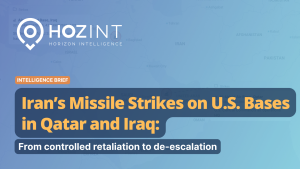Key Points
-
On May 7, India conducted coordinated airstrikes under Operation Sindoor against alleged terrorist infrastructure in Pakistan and Pakistan-administered Kashmir, following the April 22 Pahalgam terror attack.
-
India claims the operation targeted Lashkar-e-Taiba (LeT) and Jaish-e-Mohammed (JeM) militant camps, resulting in 80–90 terrorist casualties.
-
Pakistan condemned the strikes as an “act of war,” claiming civilian deaths and retaliated by downing five Indian aircraft. Islamabad has activated its right to self-defence under Article 51 of the UN Charter.
-
Cross-border shelling erupted along the Line of Control (LoC) and multiple Indian and Pakistani airports have suspended flight operations.
- Escalation risks are significantly higher than in 2019, with both conventional and diplomatic flashpoints now active.
Event Overview
What: India launched airstrikes under the codename Operation Sindoor targeting nine sites suspected of hosting terrorist infrastructure. The strikes were framed as retaliatory action for the April 22 terrorist attack in Pahalgam, Jammu & Kashmir (J&K), which killed 26 Hindu pilgrims and was claimed by The Resistance Force (TRF), a proxy linked to LeT.
When: Airstrikes commenced at approximately 01:45 local time on May 7, 2025.
Where: Strikes hit Bahawalpur, Muridke (Punjab), and Bhimber, Bagh, Kotli, Muzaffarabad, Chak Amru, Gulpur, and Sialkot in Pakistan-administered Kashmir and eastern Pakistan.
Who: The Indian Air Force (IAF) deployed Rafale, Su-30, and MiG-29 jets. Pakistan’s Air Force responded with intercepts and reportedly used PL-15 missiles to shoot down five Indian aircraft. Pakistan reported 8 civilian deaths and 35 injuries; India claimed no Pakistani military sites were targeted.
How: India conducted a multi-axis air assault focused on precision strikes. Pakistan retaliated through air intercepts and ground-based missile systems. Exchanges of artillery fire occurred in Kupwara, Kashmir, two hours post-strike, killing three Indian civilians.
Analysis
Historical Context of the Kashmir Conflict
The territorial dispute over Jammu & Kashmir is rooted in the 1947 partition of British India. When the princely state acceded to India under duress following a Pakistani tribal invasion, war broke out. A UN-brokered ceasefire created the Line of Control (LoC), but no final resolution has been reached. Since then, the region has seen repeated conflict: the Indo-Pak wars of 1947–48, 1965, 1971, and the 1999 Kargil War.
Pakistan has long been accused of supporting Islamist militant proxies such as LeT and JeM to wage an asymmetric campaign against Indian control of Kashmir. India has responded with counter-insurgency and, increasingly, cross-border kinetic strikes following major terror incidents.
A major turning point occurred in August 2019, when India revoked Article 370, which had granted special autonomy to Jammu and Kashmir. This allowed the region its own constitution and legislative powers, which were now dissolved. The abrogation marked a strategic shift in India’s Kashmir policy—from a quasi-federal arrangement to full integration under central authority.
This move was rejected by Pakistan, which views Kashmir as disputed territory, and was met with increased militant activity, crackdowns, and rising cross-border tensions. India’s decision has since framed its posture: zero tolerance for terror and a proactive regional deterrent policy.
Strategic Implications of Operation Sindoor
India’s decision to launch Operation Sindoor follows a familiar but escalated script. Like the 2019 Balakot strike, this operation was triggered by a major terror attack. However, unlike Balakot’s single-site strike, Operation Sindoor involved multiple targets, greater geographic breadth, and higher-intensity engagement, including alleged civilian casualties and the downing of aircraft.
Comparative Risk Matrix: Balakot (2019) vs Operation Sindoor (2025)
|
Risk Dimension |
Balakot (2019) |
Operation Sindoor (2025) |
|---|---|---|
|
Trigger Incident |
Pulwama suicide bombing (40 paramilitary killed) |
Pahalgam attack (26 Hindu pilgrims killed) |
|
Target Profile |
JeM camp in Balakot |
LeT & JeM camps across 9 locations in Pakistan & PoK |
|
Indian Strategy |
Single airstrike |
Multi-site campaign under “Operation Sindoor” |
|
Pakistani Response |
Shot down MiG-21; pilot captured |
Claimed 5 Indian jets downed; invoked Article 51 at UN |
|
Casualty Claims |
India: many killed; Pak: denied casualties |
India: 80–90 terrorists; Pakistan: 8 civilians killed, 35 injured |
|
LoC Activity |
Brief artillery exchange |
Sustained cross-border shelling; civilian casualties |
|
Civil Aviation Impact |
Temporary closures in both countries; rerouting |
Multiple airport closures; significant disruption to regional aviation |
|
Information Warfare |
Competing narratives; social media propaganda |
Indian PIB fact-checks; Pakistan amplifying civilian impact |
|
International Mediation |
US, UAE, China applied pressure |
UN Security Council notified; broader diplomatic pressure expected |
|
Escalation Risk |
High, but de-escalated quickly |
Higher escalation risk due to broader scope and aircraft losses |
|
De-escalation Pathway |
Return of Indian pilot catalyzed resolution |
Currently uncertain; likely via diplomatic backchannels |
The key risks include:
-
Military miscalculation and potential for escalation.
-
Public pressure on both governments to act forcefully.
-
Proxy retaliation via terror attacks in India.
-
Breakdown of ceasefire mechanisms established in 2021.
Pakistan’s swift invocation of Article 51 of the UN Charter and its international diplomatic mobilization suggest a prolonged period of strategic posturing, even as backchannel diplomacy likely unfolds.
Aviation Risk Assessment
The situation has resulted in a severe disruption to regional aviation, posing both safety and operational risks.
Pakistan:
-
All domestic and international flights grounded on May 7, according to Pakistan International Airlines (PIA).
-
Airspace closed for at least 48 hours by the Pakistan Civil Aviation Authority (CAA).
-
Sialkot Airport (SKT) closed; operations suspended indefinitely.
-
Islamabad (ISB) and Lahore (LHE) airports cancelled 25+ international flights (e.g. Qatar, Dubai, Bahrain, Kuwait, Riyadh).
-
Qatar Airways suspended all flights to Pakistan.
-
PIA cancelled all flights, citing security conditions.
India:
-
Closure of Dharamshala (DHM), Leh (LEH), Amritsar (ATQ); advisory issued by SpiceJet.
-
Srinagar Airport (SXR) fully closed; all flights cancelled.
-
Airspace restrictions above J&K, Himachal Pradesh, and Punjab in force.
These developments mirror the 2019 Balakot-Pulwama incident, where both countries briefly suspended commercial flights. However, the scale of closure in 2025 is larger, affecting more urban centers and international routes. This disrupts cargo logistics, passenger services, and international overflight corridors, particularly between the Gulf and Southeast Asia.
There is also an increased risk of collateral damage, especially in congested airspace. Airlines operating near conflict zones must maintain real-time coordination with ATCs and monitor NOTAMs for sudden changes. Insurance premiums may rise, and regulators may issue new overflight advisories if the standoff persists.
Forecast
Short-Term (0–2 Weeks):
-
Continued cross-border shelling likely along the LoC.
-
Civilian casualties may rise; airports remain closed.
-
Diplomatic statements and retaliatory rhetoric expected from both sides.
Medium-Term (1–3 Months):
-
Possibility of proxy attacks inside India by Pakistan-based groups.
-
Increased counterinsurgency operations in Indian Kashmir.
-
Third-party mediation from the UAE, US, or China could help de-escalate.
-
Resumption of normal aviation only after diplomatic stabilization.
Conclusion
Operation Sindoor marks a significant intensification of India’s retaliatory doctrine against Pakistan-based militant networks. Unlike previous limited actions, this strike’s scale, geographic reach, and immediate kinetic consequences mark a shift toward more assertive military options. With nuclear-armed rivals once again on the brink, miscalculation remains the greatest threat—particularly in a contested airspace and region marked by asymmetric provocations.
To avoid uncontrolled escalation, international diplomacy must move swiftly. The current trajectory suggests a volatile but containable crisis, provided off-ramps are prioritized before further bloodshed.




